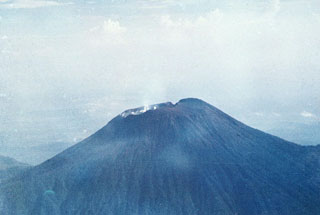Report on Slamet (Indonesia) — June 1988
Scientific Event Alert Network Bulletin, vol. 13, no. 6 (June 1988)
Managing Editor: Lindsay McClelland.
Slamet (Indonesia) Incandescent tephra; ashfall to 85 km
Please cite this report as:
Global Volcanism Program, 1988. Report on Slamet (Indonesia) (McClelland, L., ed.). Scientific Event Alert Network Bulletin, 13:6. Smithsonian Institution. https://doi.org/10.5479/si.GVP.SEAN198806-263180
Slamet
Indonesia
7.242°S, 109.208°E; summit elev. 3428 m
All times are local (unless otherwise noted)
Slamet began to erupt ash and incandescent tephra at about 1800 on [12] July. At 0700 the next morning, explosions were occurring once a minute, ejecting incandescent fragments to 500 m above the vent. Ash fell 45 and 85 km NE at Cirebon and Brebes. By 1500, eruptive activity had stopped but heavy fuming continued from one of the active craters, feeding an 800-m plume. The moderate activity was consistent with most of the volcano's 38 eruptions in the past 200 years and no evacuation was ordered.
The eruption was preceded by periods of brief harmonic tremor on 9 July and six hours of increased seimicity including brief tremor episodes on 10 July. A second radio-telemetered seismometer will be installed on the volcano.
Geological Summary. Slamet is one of Java's most active volcanoes. It has a cluster of about three dozen cinder cones on its lower SE-NE flanks and a single cinder cone on the W flank. It is composed of two overlapping edifices, an older basaltic andesite to andesitic volcano on the west and a younger basaltic to basaltic andesite one on the east. Gunung Malang II cinder cone on the upper E flank on the younger edifice fed a lava flow that extends 6 km E. Four craters occur at the summit of Gunung Slamet, with activity migrating to the SW over time. Eruptions recorded since the 18th century have originated from a 150-m-deep, 450-m-wide, steep-walled crater at the western part of the summit and have consisted of explosive eruptions generally lasting a few days to a few weeks.
Information Contacts: VSI.

